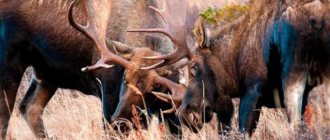Reasons for the attack
The behavior of a bear depends on several factors. What matters is his age, season, place, circumstances of the meeting:
- In winter, encountering a bear is rare. Sometimes this happens when the animal woke up for some reason (not enough accumulated fat or someone disturbed it) after leaving the den. Such bears are called connecting rods. In winter they are especially aggressive.
- Meeting near the loot storage area. The predator perceives a person as an obstacle to the meal or sees him as a competitor, so he will fight for his property.
- In early spring, bears emerge from hibernation. Over the winter they have spent their fat reserves and are hungry. Hence the tendency to aggression.
- Mating season begins in late spring. A hormonal storm promotes aggression. Males often fight with competitors. For a person, an encounter with a bear during this period promises trouble.
- A meeting with a mother bear with cubs is especially dangerous. The female perceives any living creature as a potential threat to her children. The reason for aggression is the desire to protect offspring.
- In summer the danger decreases. The explanation for this is purely physiological: there is a lot of food around, the mating season is over. However, even in summer you need to do everything possible to avoid meeting a predator.
Seasonal meeting in the forest
In spring, bears awaken from hibernation and become dangerous. Especially mother bears with cubs. There is no threat from you, first of all, to the bear cubs, and also no aggression towards the mother bear. It is explainable.
What to do if you meet a bear in the forest in summer? In July-August their mating season begins. At this time, males become aggressive, which is especially evident if there is a female within the radius of his sense of smell and touch, which may not be inferior to males in aggression. During this season, young animals can also attack, but competent actions this season will quickly scare them away. Follow the tips above, shout, sing, raise your arms or a stick above you and wave them, but do not throw yourself at the bear. If you have weapons or firecrackers, shoot in the air. Basically, in the summer there is a lot of food. Bears, as a rule, do not attack for no reason. Bears that have accumulated fat over the summer become more docile in the fall.
In winter, there is some probability of meeting a connecting rod bear in the forest. This bear does not have time to eat enough during the summer, which causes his winter vacillations. Connecting rods are very dangerous. Since there is no food, meeting them is fraught with danger. What to do if you meet a bear in the forest in winter? As you move, look for footprints in the snow. If you spot bear tracks, turn off this path.
Meeting options
You can find a bear in the forest in different situations, for example, by accidentally coming across its bedding. Depending on the circumstances of the meeting, it is recommended to structure your behavior.
Meeting with a sleeping bear
You cannot wake up a sleeping predator. You should not linger nearby, talk loudly or take photos. But you can’t run away headlong either. The stomping and cracking of branches will awaken the animal. You should calm down as much as possible and just quietly leave.
Bear eats food
Any predator is characterized by food aggression. The beast considers the stranger to be an encroachment on its food. You need to try to show the lack of any interest in other people's food.
Group of bears
Encountering several bears at the same time is uncommon, but possible. Happens for the following reasons:
- During the rut, animals become aggressive extremely easily. Since there are several predators, the chances of prey are zero. Both males and females show viciousness.
- A group of young bears, when their mother had already driven them away. The cubs live separately, but have not yet chosen their areas for independent living. Young animals are not so dangerous and are easier to scare away.
Mother bear and cubs
An extremely dangerous situation. The bear protects her children. She does not know how uninvited guests will behave, and therefore easily becomes aggressive at the sight of strangers. Even when the mother bear is away, you should not approach the cubs, no matter how cute they look.
The she-bear never leaves her children for long and will definitely return at the most inopportune moment for anyone who wants to take a selfie. You need to quickly leave quietly.
On the hunt
During a hunt, a chance encounter with a predator is possible. Even with a weapon, killing a bear is not easy. It’s better not to tempt fate, but to retreat. When you see the silhouette of an animal, you need to leave without making any noise. If the animal notices the hunter, a shot in the air will help. It is better not to shoot from an insufficiently powerful weapon. A wounded predator will only become even more angry.
Note! The risk of attack is largely determined by distance. The greater the distance, the less likely the bear is to perceive a person as invading his personal space.
Daily activity and behavior of the brown bear
Most often in taiga forests and forests of the middle zone, brown bears are active at dusk and at night, but on rainy days they often wander all day. In the alpine zone of northeastern Altai and in the mountain tundra of Kamchatka, bears are often observed during daylight hours, but mainly in the morning and evening. In the treeless mountains of the northwestern Caucasus in the summer from 8 to 10 a.m., 0.22 bears were observed in 1 hour, from 10 to 2 p.m. - 0.14, and from 2 to 6 p.m. - 0.20; Only adult bears were observed respectively in the morning - 0.11, in the afternoon - 0.04, in the early evening - 0.20. Mother bears and cubs come out earlier in the afternoon. On cloudy, rainy days, female bears often graze all day. With the transition in autumn to a strip of broad-leaved forests, closer to populated areas, bears here become nocturnal animals and hide during the day in the thickets of azalea, rhododendron, cherry laurel and ferns, or go for the day 6-8 km higher into the mountains. In the northeastern Altai (Altai Nature Reserve), in the summer, bears largely feed in alpine meadows, often during the day. However, during periods of long, lingering rains, so common in these mountains, they do not go to the highlands for many days, staying lower - in the cedar trees. But when clear and warm weather sets in, on the very first day they go out into the meadows in significant numbers and feed here all day, as if making up for lost time. Thus, brown bears do not have a clear rhythm of daily activity.
Read: Transcaucasian snake (Zamenis hohenackeri)
Despite its apparent clumsiness, the bear is silent, light and fast in its movements. Very frightened, for example, after an unsuccessful shot, it rushes at high speed in huge leaps, throwing its hind legs far forward, and is very nimble while running. At crossings, its trail is straightforward, but the animal always avoids rubble and cluttered places, meandering only at the shelters and on the approach to the den before hibernating. It readily climbs trees in its youth - in Primorye only up to 1.5 years of age. But where there are a lot of acorns, walnuts or wild bees, the bear does not lose the ability to climb all his life. In the northeastern Altai, bears, getting cones with pine “nuts,” often climb onto the tops of cedar trees and break off branches on them. Such damage has also been observed in other areas of Siberia. In Poland, bears used to be caught in traps in trees; With the degeneration of beekeeping, the bears stopped climbing.
The bear digs well - in the fall, when digging out holes and underground storerooms of chipmunks, he digs deep holes, often in rocky ground. In the alpine meadows of northeastern Altai, the long thick roots of the pennyweed are pulled out. In the middle zone, while foraging for food, it sometimes lifts up turf in forest meadows and rolls it into a tube. In the high-mountain meadows of Altai (Altai Nature Reserve), bears thus “roll up” entire large “carpets” by eating underground parts of plants and catching voles. Bears swim well, covering spaces of up to 6 km and willingly swim in hot weather, especially cubs. In an effort to get rid of blood-sucking insects, they arrange mud baths. During drought, deep holes are dug in moss swamps in search of water.
Read: Guanlong
Both adult bears and cubs scratch themselves on tree trunks, leaving fur and claw marks on them. Back in 1874, it was suggested that a bear marks its habitat with its claws, thereby preventing other bears from entering it; much later, the same opinion was expressed by E. T. Seton-Thompson (1911). Later, it was suggested that these marks are associated with the mating season, but there is a contradiction to this - fresh marks are found at different times; The cubs also leave them behind.
Usually only a wounded bear, guarding fresh prey, or an extremely exhausted, hungry bear (shatun) attacks a person (in winter). A she-bear, caught by a man with her cubs, mostly tries to scare him away by rearing up. Sometimes she rushes straight at a person. As a rule, a bear, seeing a person, runs away. The exception is the few areas where it is not pursued by hunters.
Rules of behavior when meeting
A meeting between a bear and a person creates 2 scenarios for the development of the situation:
- The predator has noticed the person, examines him, but does not take any aggressive actions.
- The beast began to approach, probably an attack.
If the bear stands still, it is recommended to perform the following actions:
- Take the most even position possible. Animals study body language. In a slouched person, animals sense fear and uncertainty. Next, smoothly raise both arms up - this will visually increase the person’s height. For a predator, the size of the opponent matters.
- Calm down, try to suppress the fear in yourself.
- Start talking. The topic of the monologue does not matter. The voice should sound confident, but not loud or aggressive.
- Start walking away slowly. It's better to go backwards. Move diagonally, keeping the animal in sight. Movements are smooth. If the predator is far enough away, go around it in an arc.
Approach does not necessarily mean a threat: the bear has poor vision and may come closer to examine the object. It is also possible that a predator tries to catch the wind in order to smell it. Sometimes, after identifying an object, the bear simply runs away. An approaching predator is not always going to attack. Often the animal just wants to oust the stranger from its territory.
If the animal is clearly aggressive, the following behavior patterns are possible:
- Fall down pretending to be dead. They do this only if contact with a bear is unavoidable. There are chances that the predator will sniff the body and leave. They only lie face down, no matter how scary it may be to lose visual control of what is happening. You cannot lie on your side or back: the bear can touch you with its clawed paw, and then the injuries to the person lying down will be much more noticeable. If everything goes well, there is no need to immediately jump up and run away. The animal may well simply step back and watch - after all, it recently saw the same object standing. You need to lie down for a while, then carefully look around and silently leave the place.
- You can really scare an approaching animal by making a loud noise. They use everything that is at hand, for example, metal objects. There are special scarecrows, for example, American shooting launchers to scare away predators. They may scare the bear, but they are 50/50 effective. It all depends on the seriousness of the beast's intentions. There are special pepper sprays on sale. Their action is limited in radius. Aerosol products are effective only in the absence of wind.
- The attacking predator must be resisted. It would be a good idea to scream and call for help (what if people are nearby). To protect themselves, they use available means, including stones, branches, sand or earth. The bear's weak spot is its eyes, so you need to try to hit them. Aggressive defense can scare away a predator, especially if we are talking about young animals.
Advice! The animal often throws dry leaves and branches at a person pretending to be dead. The main thing here is to just freeze, patiently waiting for the beast to leave.
What not to do
When you encounter a bear, you should not do the following:
- Show unmotivated aggression. Do not throw stones or sticks at the animal. An animal that did not intend to attack is able to quickly change its mind.
- Look the predator in the eye. A gaze for an animal is equal to a challenge.
- Make sudden movements. The animal understands arm swings and sharp turns of the body as aggression and is capable of delivering a preemptive strike.
- Trying to hide. This is a pointless activity. The bear will find it anyway. In addition, this is a signal to the predator that there is a prey in front of him.
- You must not turn your back on the bear. The animal will perceive this position as a signal to attack.
- Run away. An attempt to escape is usually doomed to failure. Even over rough terrain, the bear is capable of moving at a speed of 60 kilometers per hour. But the possibility of a successful escape cannot be completely ruled out. Having extraordinary physical fitness and suitable terrain offers a chance to escape. The bear is a sprinter, not a marathon runner, and he quickly loses speed. You just need to remember: an unsuccessful attempt to escape from a predator by flight will end sadly, since the animal will definitely begin pursuit.
- Sneak up on an animal. Anyone who likes to take a photo may think that the animal does not notice him. This is a misleading assumption. The animal will consider the approaching person to be an attacker and will defend itself.
- Climb a tree. Brown bears are excellent tree climbers. There is no way to be saved this way. The only exception: the tree is quite branchy and the massive beast will not be able to reach some parts of it.
- Approach the cubs.
Watch a video about how to behave when meeting a bear.
If you meet a bear
© Special
Most often, a bear shows aggression if it wants to protect its offspring from a potential threat from humans. His behavior at such moments can be different, ranging from a simple manifestation of antipathy towards the person he meets and ending with active actions, that is, a direct attack on him.
In some cases, the bear itself initiates a meeting with people. Curiosity and the smells of delicious food force him to slowly and carefully approach a tourist camp or populated area. If a bear lives nearby and often sees people, then most often it shows less aggression and can even allow people to come within a fairly short distance. However, it is better not to take risks and test the friendliness of this or that animal.
Many people are familiar with the concept of “approach threshold”. It indicates the permissible limit of approaching an animal. If it is violated and a person approaches the predator closer than permitted, then the animal sees him as an aggressor and behaves appropriately. Thus, a bear can attack a person not only when it is necessary to protect its cubs, but also in cases where it is wounded, afraid of losing its prey, or a couple of minutes ago was frightened by something or someone else.
The degree of risk of an unfavorable outcome from such an encounter with a bear depends on the season and the time of day at which the event occurred. The most aggressive and prone to attack is a bear after hibernation, awakened in winter or during the rut. These animals feel especially relaxed at night. Therefore, if you need to go to the taiga at this particular time of day, then be sure to take lighting devices with you.
Rules of behavior in the forest
There are simple rules that, if followed, will help protect you from trouble:
- After detecting signs of a bear, you must immediately leave the area. The beast is not necessarily gone forever. Perhaps he has gone off to look for food or is observing the situation from a secluded place. Signs by which one can recognize the presence of a bear: footprints, a torn up anthill, scratched tree trunks, broken young trees, torn up stumps, excrement (droppings).
- Try to get by in the forest without a dog. There are cases when a dog's behavior became the cause of a bear attack.
- You should avoid being in the forest at night. Human vision loses functionality in the dark. The bear is a nocturnal hunter, so it can navigate perfectly in the dark.
- Avoid bushes. Bears are found in such places, especially in raspberry fields. In addition, they live in dwarf cedar and willow forests.
- While in the forest, carefully monitor your surroundings. The forest is an alien, hostile environment.
- It is better to move through open spaces - there is more visibility there.
- If you encounter animals that feed on carrion, or find dead carcasses, move away. Bears are scavengers and come by scent.
- Another favorite habitat of bears is areas along river banks. There are predators fishing. Fishing time is night and before dawn.
- It is advisable to travel in groups. The chances of an attack are greatly reduced.
- Predators are repelled by the bright flames of a fire.
- You cannot feed wild animals. They gradually cease to be afraid of people, but do not acquire good manners.
- You cannot leave leftover food at the rest stop. It is useless to bury it, since the bear has a keen sense of smell.
There are no recommendations that guarantee 100% safety when meeting a bear. The main thing when meeting any predatory animal is to remain calm and try to put into practice all your knowledge in the field of animal habits. It is also important to follow the rules of behavior in the forest, avoiding getting into dangerous situations.
Simple rules to avoid meeting a bear
It’s easier to avoid meeting the beast than to frantically remember what needs to be done later. So, following these simple rules will help you avoid meeting a bear:
- move through open areas and open forests, where you can see the animal in advance and prevent a meeting with it;
- avoid bear paths, which are two parallel rows of holes, spaced about 20 cm apart from each other;
- try to avoid willow and dwarf cedar forests - the preferred habitats of bears;
- these animals can be near reservoirs, catching salmon;
- try to move in groups of several people - the likelihood of a bear attack decreases;
- if you stay in the bear area for the night, it is better to light a fire, which will scare away the animal;
- After each meal, it must be disposed of so that the odors do not attract hungry bears;
- move through the forest or mountains noisily, but without shouting. An animal located nearby will hear an extraneous sound and, most likely, will leave this place;
- do not visit places with burdocks and tall grass;
- halts should be arranged only in open areas with good visibility;
- try not to move through the supposed habitats of bears at night;
- If you are not going hunting, do not take your dog with you. She can attract the animal by barking, or when meeting him she can rush at the bear, which will only anger him;
- do not try to take a photo with the animal, the bear will not appreciate your passion for selfies.
If you do encounter an animal, but it does not show aggression, and only curiosity is visible, you need to act according to the circumstances - either slowly retreat, or try to scare it off using the methods described above. The bear has poor eyesight, but at close range you don’t need to look him straight in the eyes, he will regard this as aggression.
When encountering a bear, you should try to remain calm and clear-headed. Remember that if an animal sees a confident person, he will most likely prefer to leave. Do not try to imitate a bear's roar; the bear is unlikely to understand you.
These rules apply to any area where animals can be found. In particular, they are applicable when answering the question: “What to do if you meet a bear in the taiga?” In this situation, it is better to take lighting devices with you: flashlights, cameras with flash, in order to temporarily blind the animal and try to move away during this time.











